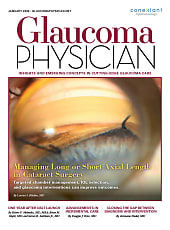IN MARCH 2023, VUITY (Allergan/AbbVie) ophthalmic pilocarpine 1.25% received FDA approval for twice daily dosing for treatment of presbyopia, with the second dose being administered 3-6 hours after the first. Many of us who have prescribed Vuity for our patients since it became available in 2022 were already prescribing it to be used off label twice per day (BID). Now, we have a study backing up our previous notions and showing that BID dosing of Vuity is both safe and effective.
The phase 3 study, VIRGO, looked at the use of 1 drop of Vuity or vehicle BID OU with each dose administered 6 hours apart. The study had a total of 230 participants, with ages ranging between 40 and 55 years old with complaints of poor near vision, best-corrected distance vision >20/25, and mesopic pupil diameter of <8.0 mm in both eyes. Patients who had severe dry eye disease, corneal abnormalities affecting visual acuity, narrow angles, or a history of cataract surgery or lens opacities were excluded from the study (see Table 1 for a complete list of inclusion and exclusion criteria).
| KEY INCLUSION CRITERIA | KEY EXCLUSION CRITERIA |
|
|
| CDVA = corrected distance visual acuity, DCNVA = distance-corrected near visual acuity | |
The primary efficacy endpoint looked at the proportion of patients in the trial who gained >3 lines in mesopic, high-contrast, binocular distance-corrected near visual acuity (DCNVA) with no more than a 5-letter loss in mesopic corrected distance visual acuity (CDVA) with the same refractive correction at day 14, hour 9. The results showed that 53.5% of patients had an improvement of >3 lines at near by 1 hour after drop instillation, dropping to 37.7% by hour 3 after the first drop instillation and 27.2% at hour 6. After the second drop was instilled, the percentage of patients bounced back up to 54.4% at hour 7.
TAKE HOME POINTS
- Vuity received an approval for twice-daily dosing – the second of which can be administered 3 to 6 hours after the initial dose.
- With the approval of twice-daily dosing, the duration of effect of Vuity may be extended for up to 9 hours.
- The most common adverse events occurring at a frequency of >5% were headache and eye irritation.
- The ability to dose a second time will provide patients with flexibility to adjust their dosing based on their near vision needs.
The secondary efficacy endpoint measured the proportion of participants gaining >3 lines in photopic, high-contrast binocular distance-corrected near vision with no more than a 5-letter loss in photopic CDVA at the same time point. There were 32.5% of patients in the treatment arm who met the secondary outcome, while only 6% in the vehicle arm did.
Similar to the original FDA studies, the most common treatment-emergent adverse events (TEAEs) reported in the treatment arm were headache, followed by eye irritation, visual impairment, punctate keratitis, and eye pain. Only 24.6% of patients in the treatment arm noted a TEAE, and only 1 patient discontinued, while 11.2% of patients in the vehicle arm had TEAEs, and 2 patients discontinued. Only 1.8% of patients in the treatment arm experienced new onset of vitreous floaters, and no retinal detachments or significant changes in IOP occurred during the study in either arm.
In light of the recent concerns regarding retinal detachment and use of Vuity, the package insert does disclose a warning and precaution regarding the risk of retinal detachment. It advises that all patients should receive an examination of the retina prior to initiation of therapy and to seek immediate medical care in case of sudden onset of flashing lights, floaters, or vision loss.
The release of the VIRGO study and the change in FDA labeling are chances for us to reset, rethink, and reapproach our patients in the setting of using Vuity. This opportunity is also important since the FDA approval of the next few presbyopia treatment drops is quickly approaching. This category of medication for presbyopia is new, and it will take some time for eyecare professionals to learn which drop will work for which patient in each stage of dysfunctional lens syndrome. It is important to maintain an open discussion with our patients regarding realistic expectations and an open mind to trying new things in a different way. ■









